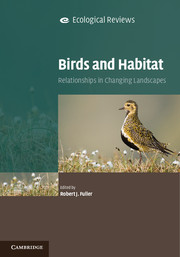Book contents
- Frontmatter
- Contents
- List of Contributors
- Preface
- Part I The complexity of patterns and processes
- Part II Case studies of habitat use and selection
- Chapter Eight Spatial variation and habitat relationships in moorland bird assemblages: a British perspective
- Chapter Nine Arctic-alpine mountain birds in northern Europe: contrasts between specialists and generalists
- Chapter Ten Bird–habitat relationships in reedswamps and fens
- Chapter Eleven Breeding waders on wet grassland: factors influencing habitat suitability
- Chapter Twelve Processes influencing bird use of estuarine mudflats and saltmarshes in western Europe
- Chapter Thirteen Avian habitat use on the non-estuarine intertidal coast
- Chapter Fourteen Temperate western European woodland as a dynamic environment for birds: a resource-based view
- Part III Wider perspectives
- Species index
- Subject index
- References
Chapter Thirteen - Avian habitat use on the non-estuarine intertidal coast
Published online by Cambridge University Press: 05 December 2012
- Frontmatter
- Contents
- List of Contributors
- Preface
- Part I The complexity of patterns and processes
- Part II Case studies of habitat use and selection
- Chapter Eight Spatial variation and habitat relationships in moorland bird assemblages: a British perspective
- Chapter Nine Arctic-alpine mountain birds in northern Europe: contrasts between specialists and generalists
- Chapter Ten Bird–habitat relationships in reedswamps and fens
- Chapter Eleven Breeding waders on wet grassland: factors influencing habitat suitability
- Chapter Twelve Processes influencing bird use of estuarine mudflats and saltmarshes in western Europe
- Chapter Thirteen Avian habitat use on the non-estuarine intertidal coast
- Chapter Fourteen Temperate western European woodland as a dynamic environment for birds: a resource-based view
- Part III Wider perspectives
- Species index
- Subject index
- References
Summary
Non-estuarine (‘open’) coasts provide extensive and varied habitats for birds. Rocky intertidal shores, in particular, can provide abundant food resources for several species, notably waders (Feare and Summers, 1985). These resources and the bird assemblages that use them are fundamentally different in several respects to those occurring within estuaries (Chapter 12). This chapter reviews the bird assemblages that use intertidal habitats outside estuaries, habitat associations and constraining factors, interactions between the use of the open coast and supratidal and other adjacent habitats, and the impacts of recent environmental changes on avian assemblage composition and habitat relationships. The focus is on intertidal habitats and not other open coast habitats such as dune systems, coastal scrub and cliffs; this wider, highly varied range of coastal environments supports diverse assemblages of migrating and breeding birds, most notably of passerines and breeding seabirds. While the chapter primarily considers the avian assemblages that use non-estuarine intertidal habitats in Europe, in particular Britain, I also draw on studies from elsewhere in reviewing the factors and environmental changes that affect habitat use.
Non-estuarine intertidal habitats and their bird assemblages
The intertidal habitats found on the open coast include both soft-substrate (typically sandy) shores and rocky shores of exposed bedrock, boulders and shingle (gravel), the character of which depends greatly on the prevailing rock type and the shore’s exposure (Little et al., 2009). Rocky shore habitats can be highly varied and complex, and in Britain, at least, may be extensively covered by beds of mussels (chiefly Mytilus edulis), limpets, barnacles and seaweed (including brown algae such as Fucus, Ascophyllum and Pelvetia, and green algae such as Ulva), while subtidal areas can support dense beds of kelp (e.g. Laminaria) (Connor et al., 2004). These habitats support a varied avifauna, both in the breeding and, notably, the non-breeding seasons – a previous review of bird species utilising rocky shores, for example, reported that a total of 47 species fed in the rocky intertidal zone at Robin Hood’s Bay, Yorkshire (Feare and Summers, 1985).
- Type
- Chapter
- Information
- Birds and HabitatRelationships in Changing Landscapes, pp. 334 - 351Publisher: Cambridge University PressPrint publication year: 2012
References
- 1
- Cited by



